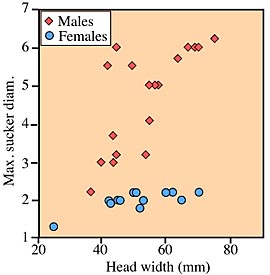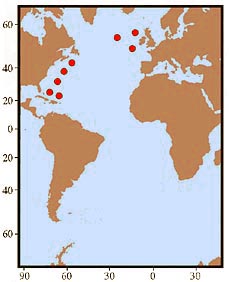Stauroteuthis syrtensis
Martin Collins, Richard E. Young, and Michael VecchioneIntroduction
Stauroteuthis syrtensis appears to be relatively common off the continental slope of the eastern USA although it occurs across the North Atlantic. It has been observed off the USA from submersibles (e.g., Vecchione and Young, 1997, Johnsen, et al., 1999) and is regularly caught in bottom trawls at the appropriate depths (Vecchione, pers. obs.). A video of this species can be found here.
Diagnosis
See "Comments" below.
Characteristics
- Arms
- Males with sexually dimorphic suckers: Suckers 1-8 small, barrel shaped; suckers 9 to 22-25 enlarged, conical (see drawings on upper right); suckers 9-12 closely packed; suckers 13-18 largest; maximum sucker diameter 6.5 mm.
- Females with arm suckers uniformly small: Maximum diameter found on suckers 1-3, largest sucker diameter 2.2 mm; suckers 1-4 tightly packed, barrel shaped; suckers 5 to about 24 small and well spaced, separated by up to 15 mm (see drawings on lower right). Horizontal scale bars 100 mm, vertical scale bars 2 mm.
- Both sexes: suckers distally from number 19-24, become smaller, closely packed and more cyclindrical; suckers minute at arm tips.
 Click on an image to view larger version & data in a new window
Click on an image to view larger version & data in a new window
Figure. Oral view of arms and side view of suckers of S. syrtensis. Top - Male arm, R.V. DISCOVERY Sta. 52104, with proximal, mid-arm and distal sucker enlarged. Bottom - Female arm, same octopod as in title drawing (R.V. DISCOVERY Sta. 51014), with proximal, mid-arm and distal sucker enlarged. Drawing from Collins and Henriques (2000).
- Head
- Beaks: Descriptions can be found here: Lower beak; upper beak.
- Beaks: Descriptions can be found here: Lower beak; upper beak.


Figure. The graph relates the maximum sucker diameter to the size of the octopod. Head width is used as the size standard since mantle length is highly variable due to fixation and preservation. Sexual dimorphism in sucker size between males and females is clearly demonstrated by the chart. Chart modified from Collins and Henriques (2000).
Comments
This description is taken from Collins and Henriques (2000). More details of the description of S. syrtensis can be found here.
This species is most easily separated from S. gilchristi by the larger sucker size in the latter (S. gilchristi females up to 5 mm in maximum sucker diameter and males up to 9 mm in maximum sucker diameter compared to 2.2 mm in females and 6 mm in males of S. syrtensis), and the more distal position of the largest suckers in the latter females (suckers 1-3 in S. syrtensis vs 9-14 in S. gilchristi. The latter feature suggests the that S. gilchristi lacks sexual dimorphism in sucker size.
Nomenclature
Chunioteuthis ebersbachii Grimpe, 1916 is a junior synonym of Stauroteuthis syrtensis (Voss, 1988; Collins and Henriques, 2000).
Life History
Maximum length of eggs found in the oviducts were 11 mm and the largest ovarian eggs were 9.5 mm. The ovary has about 900 oocytes of which 22 were more than 8 mm long. Most oocytes were less than 1 mm in length. About 40 sheaths, presumably from eggs that had been released, were found in the ovary.
Distribution
Distribution records for octopods examined by Collins and Henriques, 2000 indicate that S. syrtensis is widespread in the North Atlantic where they are found near bottoms of 500 to 4000 m with maximum abundance between 1500 and 2500 m.
References
Collins, M. A. and C. Henriques. 2000. A revision of the family Stauroteuthidae (Octopoda: Cirrata) with redescriptions of Stauroteuthis syrtensis and S. gilchristi. J. Mar. Biol. Ass. U.K., 80: 685-697.
Johnson, S., Balser, E. J., Fisher, E. C. and E. A. Widder. 1999. Bioluminescence in the deep-sea cirrate octopod Stauroteuthis syrtensis Verrill (Mollusca: Cephalopoda). Biol. Bull. Mar. Biol. Lab., Woods Hole, 197: 113-114.
Vecchione, M. and R. E. Young. 1997 Aspects of the functional morphology of cirrate octopods: locomotion and feeding. Vie Milieu 47(2):101-110.
Title Illustrations

| Scientific Name | Stauroteuthis syrtensis, Stauroteuthis syrtensis (2) |
|---|---|
| Location | Cape Hatteras, U.S.A, SW U.K. (2) |
| Reference | Vecchione, M. and R. E. Young. 1997 Aspects of the functional morphology of cirrate octopods: locomotion and feeding. Vie Milieu 47(2):101-110., Collins, M. A. and C. Henriques. 2000. A revision of the family Stauroteuthidae (Octopoda: Cirrata) with redescriptions of Stauroteuthis syrtensis and S. gilchristi. J. Mar. Biol. Ass. U.K., 80: 685-697. (2) |
| Sex | f (2) |
| Size | ca. 90 mm ML, 72 mm ML (2) |
About This Page
Martin Collins

Aberdeen University, Aberdeen, UK

University of Hawaii, Honolulu, HI, USA

National Museum of Natural History, Washington, D. C. , USA
Page copyright © 2002 Martin Collins, , and
All Rights Reserved.
- First online 30 January 2002
Citing this page:
Collins, Martin, Richard E. Young, and Michael Vecchione. 2002. Stauroteuthis syrtensis . Version 30 January 2002 (under construction). http://tolweb.org/Stauroteuthis_syrtensis/20187/2002.01.30 in The Tree of Life Web Project, http://tolweb.org/









 Go to quick links
Go to quick search
Go to navigation for this section of the ToL site
Go to detailed links for the ToL site
Go to quick links
Go to quick search
Go to navigation for this section of the ToL site
Go to detailed links for the ToL site